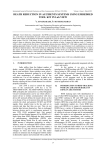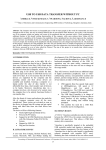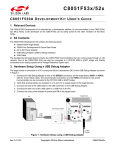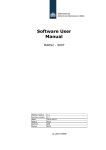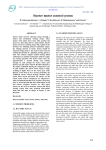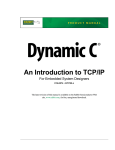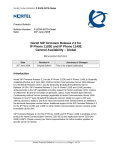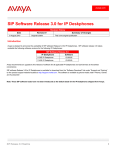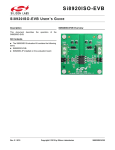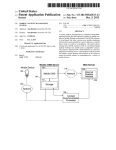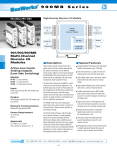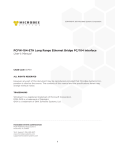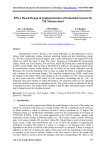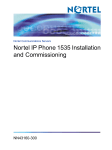Download TCP/IP Implementation Using Embedded Controller
Transcript
1
TCP/IP Implementation Using Embedded Controller
TCP/IP Implementation Using Embedded Controller
S. Ganesh
Sri Muthukumaran Institute of Technology, Chennai-69
ABSTRACT: This paper deals with the design of an Embedded Web Server based on MCS51Family Controller.
The designed embedded system hosts a small w eb page, which is served with the dynamic data upon the client http
request. The entire system is developed around MCS 51 and Ethernet development board. This system enables a
user to monitor and control a physical quantity from a remote location through Internet.
Keywords—TCP/IP, Embedded, Ethernet, Simple Mail Transfer Protocol (SMTP).
INTRODUCTION
A
n Embedded system is device that has computer
intelligence and dedicated software to perform a
single task, or group of related tasks. Embedded Systems
are often used to do monitoring and controlling functions
such as gathering sensor readings and controlling relays
and motors.
Ethernet is the technology, used to connect computers in
home and offices. It is also possible to interconnect
networks by router and Gateways. The work done in this
paper bridges the gap between the Ethernet technology and
Embedded Systems. One development that has made
Ethernet feasible for embedded systems is the availability
of inexpensive controller chips to handle the details of
Ethernet communications. The CPUs that provide the
processing power for embedded systems have also faster
and more capable of handling the demands of
communicating with the controllers. Internet protocols
provide standard, well-documented ways of exchanging
data. Both Ethernet and the Internet protocols are free and
open standards available for use without royalties or
licensing fees.
EMBEDDED WEB SERVER
Normally Web Server is a computer in which lot of web
pages are stored. Web Server for hosting a corporate web
page should have the capability to handle more traffic.
The aim of this work is to neither hosting a corporate
web pages nor handling much traffic.
Internet
Relay
CLIENT
H
U
B
ETHERNET
MODULE
Temperature
Sensor
Analog
signal
Fig. 1: Block diagram representation of Embedded Web
Server
An embedded system that functions as a Web server
generally has all of the following:
• Non-volatile memory to hold pages to be served.
• Support for TCP and IP. Requests for Web pages and
the pages sent in response travel in the data portion of
TCP segments.
• Support for HTTP. The server must be able to
understand and respond to receive requests for Web
pages. The HTTP standard specifies the format for the
requests and replies.
• A local-network or Internet connection. To serve pages
on the Internet, the Web server must have an Internet
connection. Any firewalls must be configured so the
system can receive HTTP requests.
• One or more pages to serve. The Web pages are files or
blocks of text that use a form of encoding called
hypertext markup language (HTML). The HTML
encoding specifies the for matting of text and images on
the page, including text size and fonts and the
positioning of text and other elements on the page. The
HTML code may include links to images that appear on
the page, as well as links to other pages or resources. In
serving a Web page with dynamic content, the software
must have a way of inserting the dynamic content as the
page is being served.
SOFTWARE DESIGN
The heart of the Embedded Web server is the software,
which is running in it. In this work using Dynamic C™
Integrated Development Environment develops the
software. To make the Controller communicate to Internet,
TCP/IP stack should be implemented in the software. The
software development in Dynamic C is easier, as it comes
with TCP/IP stack.
Many Web pages are static. That is the content of web
page remains the same for every http request. It doesn’t
have any dynamic content, like date or time, the value of
which is changing. Embedded Web servers are often used
to display the real time information such as sensor reading
90
Mobile and Pervasive Computing (CoMPC–2008)
from a remote location. This necessitates that the web page
is served with dynamic content. Here the dynamic content
is the sensor reading, which may change with time.
To deliver the web page with dynamic content, Server
Side Include (SSI) directives are used. It instructs the server
to insert the values of variable in the appropriate locations
in the web page. The following HTML code includes SSI
Directives.
<html>
<head>
<title>Temperature Monitor</title>
</head>
<body>
<h1> Temperature Monitoring Demo</h1>
<p>Temperature: <!--#echo var=“Temperature”-></p>
</body>
</html>
A Server Side Include directive uses the same delimiters
as a HTML comment. A comment, which is text that the
browser ignores and doesn’t display, is enclosed by <! -and -->. On receiving a page that contains an HTML
comment, the browser displays the page the same as if the
comment and its delimiters weren’t present.
Another use for comment delimiters is to enable a page
to specify Server Side Include (SSI) directives that the
server executes before serving the page to the browser.
Before serving a page containing an SSI directive, the
server executes the directive and replaces the delimiters and
the text between them with the result of executing the
directive. If for some reason the server doesn’t support the
directive, the server ignores the directive and the browser
treats the directive as a comment, which isn’t displayed.
Till this point it has been stated about web page design.
In the following section, the development of embedded
application is described.
The application requires the dcrtcp.lib library, which
supports TCP/IP and related protocols, and the http.lib
library, which supports HTTP. To make embedded web
server application, these libraries has to be included.
The MCS51 module has 8 channels, 12-bit Analog to
digital converter, AD7870. This ADC supports
programmable gain and it has a conversion time of 180µs.
In this application a thermistor is used to measure the
temperature and the temperature is stored as a variable,
whi ch will be attached with the web page and served to
client.
sock_init();
http_init();
tcp_reserveport(80);
while (1) {
update_temp();
http_handler();
}
In above code segment sock_init() initialize the packet
driver and transfer control protocol. http_init() initialize the
http daemon. This must be called after sock_init(), and
before calling http_handler() in a loop. This sets the root
directory to “/” and sets the default file name to
“index.html”. Tcp_reserveport is used by servers to give
special treatment to remote sockets that connect to the
specified port. If a connection is made to a reserved port
and there is currently not a listening socket to handle it, the
system will try to hold the connection open until a listening
socket is available.
This allows a server to handle multiple requests
smoothly even if only a few sockets are allocated. Port
number 80 is reserved for Hyper Text Transfer Protocol.
Then in an infinite loop, two functions are alternatively
called, in which, update_temp() is used to update
temperature values and the library function http_handler()
is a tick function to run the http daemon. It must be called
periodically for the daemon to work.
In this work the remote control is also done, by using
some user interfaces such as buttons in the web page. By
clicking the button, the remote user can give commands to
microcontroller, which in turn controls the relay.
HARDWARE DESIGN
The MCS51Controller is used to host web pages. This
microcontroller has 5 parallel ports, six serial ports, three
timer units Timer A, Timer B and Timer C.
This microcontroller has 24-bit address bus and it needs
two clock inputs. One is fast clock used as processor clock
and a slower clock for peripherals like Real Time Clock,
Watchdog Timer, etc. This Controller reduces the EMI,
though it runs at the maximum clock speed of 125 MHz.
The internal blocks, Clock doubler and spectrum spreader
are used to reduce EMI.
In this work Ethernet core module is used with its
prototype board. This core module has Ethernet Controller,
512K Flash, 512K SRAM, an A/D converter AD7870, and
optional NAND Flash.
Fig. 2: Ethernet module Sub Systems
91
TCP/IP Implementation Using Embedded Controller
In this core module, A/D converter AD7870’s
8th Channel LN7 is connected to thermister, such that the
temperature variation is sensed as voltage variation.
The following figure shows the web page delivered by
the Embedded Web Server.
Fig. 3: Resistor Divider Network for Analog Inputs
The above diagram shows the input circuitry of the
AD7870. The resistive divider acts as a 10:1 attenuator and
the capacitors are used to filter out noises.
The core module has RTL8019AS Ethernet controller
and RJ45 connector. The RTL8019AS is a highly
integrated Ethernet Controller which offers a simple
solution to implement a Plug and Play NE2000 compatible
adapter with full-duplex and power down features. With the
three level power down control features, the RTL8019AS is
made to be an ideal choice of the network device.
The full-duplex function enables simultaneously
transmission and reception on the twisted-pair link to a fullduplex Ethernet switching hub. This feature not only
increases the channel bandwidth from 10 to 20 Mbps but
also avoids the performance degrading problem due to the
channel contention characteristics of the Ethernet
CSMA/CD protocol.
TEST AND RESULTS
In this work, an embedded application is developed to serve
the web page with dynamic content and with the user
interfaces like buttons. The embedded application is tested
in a Local Area Network. After downloading the web page
and the application, by removing the programming cable
the processor is put into run mode. In run mode, when the
Controller is reset, it starts execution from 0 × 000000.
The board is connected to the hub via a straight through
cable. It is assigned an IP address of 192.168.1.4 and a
subnet Mask 255.255.255.0.
Then the processor is reset to run the application. Now
in a desktop PC which is connected to the same network, a
browser application is opened. In the address bar of
browser, the IP address 192.168.1.4 is typed to make an
http request to the Embedded Server. After getting the http
request from the client, the server delivers the web page
with the dynamic content.
Fig. 4: Snapshot of web page served by Embedded Web
Server
To connect the Ethernet kit to internet, the board has to
be connected to an Internet modem with a static IP address
and the web hosting service is allowed by the Internet
Service Provider.
CONCLUSION & FUTURE WORK
In this paper, design of an embedded web server based on
MCS51 Microcontroller is presented. The application
developed in MCS51, works as a web server. The
application is capable of serving the web page with
dynamic content. The user in the client machine can also
give command to the microcontroller by the User Interfaces
in the Web page.
There are plenty of applications in which it is so useful
that an Embedded System should communicate to the
world through internet. For example, a vending machine
which sells the cool drinks, can communicate to the
distributor through internet to tell that it is going out of
stock. Like this Internet communication capabilities of the
Embedded Systems will start new avenues in Embedded
Automation Industry.
This project can be enhanced using CAN controller for
processing CAN dat a and using Wireless sensors to gather
parameters.
Having been in the starting of 21 st Century, We our- self
witnesses the rate of spread of internet through out the
globe. So by giving Internet Communication capabilities to
your embedded system, you are providing the capability to
your system to communicate with every corner of this
planet.
92
REFERENCES
[1] Hashmi, Atif G., Mdik, Haroon W. Pervaiz, Aman and
Younas., Muhammad, “Efficient and Cost Effective
Approach to Control and Monitoring Area Network
(CMAN)” IEEE Tr. Internet comp., 2002.
[2] Axelson., Jan, “Embedded Ethernet and Internet Complete.
Designing and programming small devices for networking”
Penram Publications.
Mobile and Pervasive Computing (CoMPC–2008)
[3] http:// www.Siliconlabs.com.
[4] MCS5100 user manual.
[5] Wu, Li Wei, and Hu., Jwu Sheng, “Distribut ed Embedded
Ethernet Platform for Robots Control.” IEEE International
Conference on Mechatronics, Taiwan, 2005.
[6] Richard Stevens, W., “TCP/IP Illustrated”, The Protocols,
Volume1.




